SnowStorm APRS Digipeater Project - Thu, Oct 16, 2014
Snowstorm Ranch (grid CN90TQ) is the double-edge sword of getaway. No cell service, isolation from the outside world, power via generator only if we need it, water to the house comes from a natural spring. However, when the guys go out deer hunting, there is no way to track where they are going, or if they broke down. There is a lot of BLM land thats huntable out here, and if the sun went down and the guys weren’t back yet, where do we start looking?
Enter APRS.
Right after Field Day up here, I got the bright idea to install an APRS tracker on the John Deer Gator that they take hunting. However this proved to have a few challenges:
-
No internet access. This system would be 100% reliant on RF, this also included the maps on the laptop which would have to be downloaded and cached on the netbook before the trip.
-
No stable power to where the camp radio setup would be. Easy to remedy by an extension cord ran under the house to the bar where the radios were setup. For the times that the generator was off, a PwrGate on a bank of gel-cells would provide a seamless cutover from the generator.
-
The permanent APRS digipeater is on a nearby mountain, K6LRC-3. I was unsure if we would get reception into camp since we’re in the RF shadow of a nearby mountain.
-
We have K6LRC-3 digipeating, and the house (KG6EYC) would digipeat. What about the nulls caused by the various hills and mountain around the camp?
-
The antenna setup at the house had to be somewhat high gain, but had to be hoisted in the tree here. Mag mounts were out, however homemade twin-lead j-poles were both light and very hoistable.
As far as reception into camp (the biggest issue) the answer was clear. I had to build a fill-in digi that could live in 100% isolation on the side of the mountain filling in where the digipeater nulls lie. It would have to take all traffic from K6LRC-3 and any APRS transmitters (ie: the Gator) and digipeat it into camp where I could view it on a map on my laptop.
There was an issue between using good high-quality hardware, and hardware that I wasn’t afraid to either be toasted by a rainstorm or have it walk away by some unknown hunter. It also had to be isolated in terms of powering. The radio/TNC have low current draw, but short of carrying 100 lbs of batteries on the mountaintop, there has to be a means of recharging the batteries.
The radio I chose was a Baofeng UV5R+ with a ‘battery saver’ battery pack that took 12v via a cig lighter meant for cars. The TNC was a Byonics TinyTrak4 with its GPS antenna. Rather than dick-around with making my own cables, I bought the Kenwood interface/power cable from Byonics that I knew would be wired correctly. For power, I used 2 gel-cell 7Ah alarm batteries and a 100W solar panel to keep the batteries happy during the day. For the solar charge controller I used a KI0BK charge controller which for the price, offered a rich feature set (ie: it worked damn well and had powerpoles built-in). All power cables were fitted with powerpoles for compatibility. The antenna was a twinlead J-Pole cut for 2m and tested/tweaked for a 1:1 SWR on 144.390.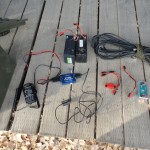
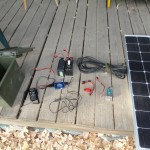
All of the above was housed in a plastic ammo box with a notch cut where the lid met the case to offer protection from the elements, as well as trapping any heat the TNC produced to keep the batteries warm during the cold nights (that dropped to near freezing).
After acquiring all the hardware, it lived at my parents house for a week testing out the batteries. I increased the battery capacity from 1 gel cell to 2, and upgraded the panel from 30W (that I had already) to a new 100W panel. I also tweaked the audio-out on the Baofeng, and turned off squelch; allowing the TNC to do the heavy lifting of determining if a signal was incoming (vs relying on breaking squelch and losing the first few bits of the packet). Although having an open squelch on the Baofeng meant an small increase in current draw, I wanted reliable vs efficient.
The next challenge was determining where to put it. Fortunately I relied on a good friend, Ben, N7AMD who was generous enough to do some computer RF plotting to determine the coverage map from not only K6LRC-3 but also the camp based upon elevation, coax length, map of the land, and power output. I was given coordinates on the side of Snowstorm Mountain to put the digipeater so it would have an RF line to not only camp, but K6LRC-3.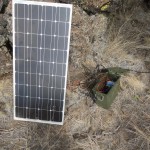
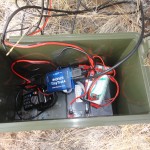
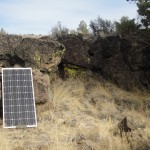
Now know that all of this was untested. Once we got up to camp, cell service was non-existant, and email was spotty (via WinLink2k) so I was all on my own.
Once we got into camp, I found out that K6LRC-3 came in spotty, but readable. This was a good sign that I’ll get reliable packets into camp. I placed the fill-in digipeater (KG6EYC-1) close to where Ben told us to put it. There was an issue in getting to the exact coordinates, so I threw the twinlead J-Pole into the highest tree closest to the coordinates that had a clear south view of the sun (for the panel). The spot was near a rock wall that offered wind/rain protection and a stable surface to point the panel without any shade from nearby trees/rocks.
The final spot was: 40°38.23′ N 120°22.94′ W – locator CN90TP42CW
The Gator was fitted with a Byonics MicroTrak FA. A plug-and-play beacon-only APRS transmitter with a mag-mount GPS and a mag-mount antenna. It put out about 10w and was powered via 12v cig lighter (which the Gator had). It offered SmartBeaconing so as not to hose the APRS frequency with a ton of useless packets.
Home-base was powered by a laptop running APRSIS/32, plugged into a Kantronics KPC3+ into a IC706mkIIG at 50W. The antenna is a twin-lead J-pole hoised up as high as I could throw a coke-bottle into the tree. I would have to say 20-30ft. The coax was fed under the house up to the bar so it wouldn’t trip anyone.
Anyway, back to my story.
It was a long Gator ride back as the one-way beacon on it (KG6EYC-12) happily sent its positions to whomever would listen. Once I got back into camp, I ran to the laptop to check the packet logs.
It worked. Holy shit it worked. I needed a drink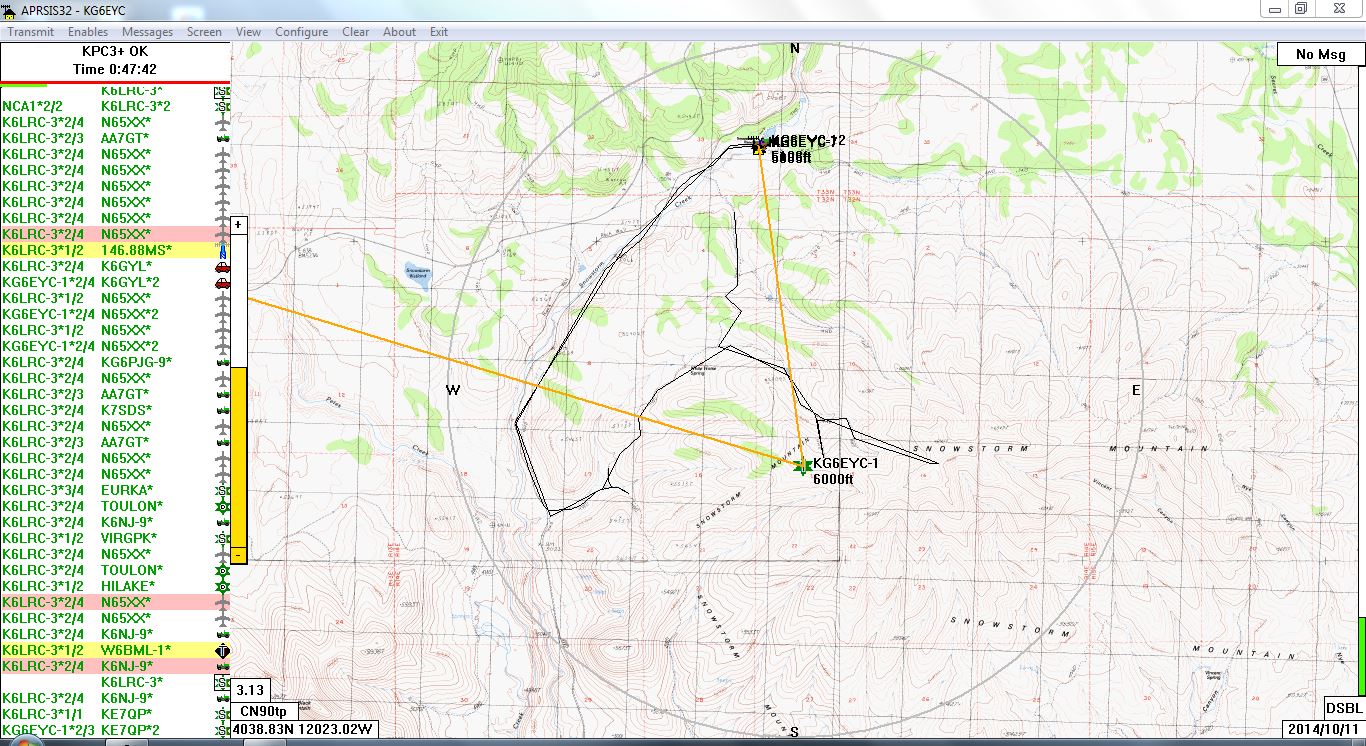
I was getting spotty packets from K6LRC-3 and full quieting packets that were digipeated via KG6EYC-1. It was doing exactly what it was supposed to do. Hourly beacons showed the battery was 13.8v and the temp was hanging at around 108F. Since this was during the day, the panel (and charge controller) was doing exactly what it was supposed to do. At night the batteries hung around 12.7v and never dipped down below 12.5v overnight. The low 36F nights had no effect on the batteries since the TNC kept the box around 60-70F. Once the sun came up, the TNC reported 13.7v as the panel charged the batteries.
There was quite a bit of overlap between K6LRC-3, KG6EYC-1 (the fill-in digi) and KG6EYC (base-camp). However the fill-in digi really proved its worth where it was the only signal-source into the house from remote areas that were shadowed by K6LRC-3 and out of the valley in view of KG6EYC (base camp).
All in all, the fill-in digi (and APRS tracking) was a hit back in camp. Meals could be planned when the Gator started to head back into camp, and the added safety-net of being able to track where they were at gave a small peace of mind in the event of a breakdown. Plus the guys at camp enjoyed looking at the laptop map and seeing exactly where the Gator was at. The ability of having an isolated RF-only system independant of the internet was a big win. Here at camp, I was recieving APRS packets that had traveled 5 hops (!!) via the digis around here.
The fill-in digipeater was a really fun project to build. It offered a low cost solution that would be great for any ham event (bike-a-thons) that needed a quick digi setup. I’d like to express my deepest thanks to Ben, N7AMD for the RF mapping, setting up skeds with the reddit guys via WinLink (even though the bands sucked when I was up here) and general shenagians on the reddit amateur radio IRC channel with the planning of this project (FB OM FB!). I’d also like to thank the Lassen Amateur Radio Club for setting up 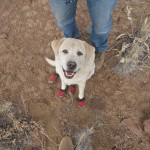 K6LRC-3 which is a killer digipeater setup all alone on Fredonyer Peak.
K6LRC-3 which is a killer digipeater setup all alone on Fredonyer Peak.
If you made it this far, I present to you my dog with her booties on top of where the digi lived.
For those of you who wish to duplicate my efforts, here is the TT4 config thats directly copy/pasteable to set your TT4 up. Obviously change the call/status beacon text for your setup (change YOURCALL-1 in the config to the call you want before importing, duh). This config assumes you have the GPS attached (hence the coordinates).